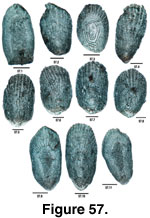 Description
Description
Platichthys stellatus (Starry Flounder)
(Other common names: Grindstone, Leatherjacket)
Figure 57.16
 Description
DescriptionLength: 91 cm.
Mouth: small, terminal; narrow gape; asymmetrical; maxillary reaches to a point below the anterior edge of the lower orbit; teeth on blind side jaw; snout blunt.
Body: caudal fin arched with a heavy first haemal spine; pectorals fins bluntly pointed; dorsal fin originates over the upper eye; lateral line slightly curved over pectoral region and then straight; no accessory branch; distinct bony plates or tubercle plates over the body; there is a tendency for this species to also be left-handed.
Color: dark brown to black with blotches on the eyed side; white to cream on the blind side; unpaired fins (anal, dorsal, and caudal) have black bands separated by orange-white stripes.
Depth: up to 275 m.
Habitat: generally soft substrates; generally an inshore species that can tolerate low salinities, moving into estuaries to spawn; move into deeper waters during the winter.
Season: spawn in early spring (February-April); earlier in southern waters; young are common in estuaries and low salinity rivers.
Diet: young feed on crustaceans such as copepods and cladocerans; adults feed on polychaetes; mussels and larger crustaceans (e.g., crabs, shrimps).
Predators: marine birds, marine mammals (Simstead et al., 1979).
Distribution: southern California to Alaska to the Bering Sea to Korea.
 Scale Description
Scale DescriptionType of Scale: stellate plates without circuli (not illustrated) predominately on the eyed side; cycloid scales on the blind side.
Relative Scale Size: small.
Position of Scales on Body: stellate plates irregularly distributed on the body; cycloid scales along the bases of the dorsal and anal fins (Hart, 1973).
Overall Scale Shape: circular to ovoid with slightly elongated lateral fields.
Focus and Circuli: focus is not centralized and is approximately one-quarter of the total scale length from the edge of the posterior field. The circuli are tightly compacted in the lateral fields and somewhat less so in the anterior. The circuli are continuous in the anterior and lateral fields and in the posterior field are discontinuous (almost protruberances).
Radii: numbers are variable and not diagnostic. Present in the anterior field only (radii not present in all fields, Batts, 1964). The outer edge of the anterior field is convex and slightly scalloped. Intermarkings absent (Batts, 1964).